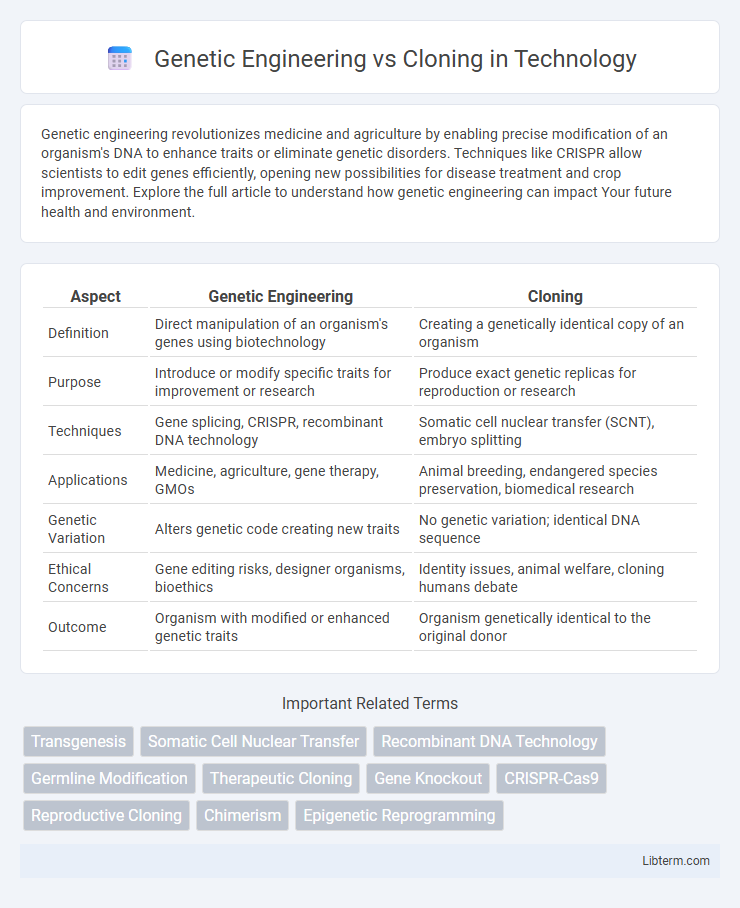Genetic engineering revolutionizes medicine and agriculture by enabling precise modification of an organism's DNA to enhance traits or eliminate genetic disorders. Techniques like CRISPR allow scientists to edit genes efficiently, opening new possibilities for disease treatment and crop improvement. Explore the full article to understand how genetic engineering can impact Your future health and environment.
Table of Comparison
| Aspect | Genetic Engineering | Cloning |
|---|---|---|
| Definition | Direct manipulation of an organism's genes using biotechnology | Creating a genetically identical copy of an organism |
| Purpose | Introduce or modify specific traits for improvement or research | Produce exact genetic replicas for reproduction or research |
| Techniques | Gene splicing, CRISPR, recombinant DNA technology | Somatic cell nuclear transfer (SCNT), embryo splitting |
| Applications | Medicine, agriculture, gene therapy, GMOs | Animal breeding, endangered species preservation, biomedical research |
| Genetic Variation | Alters genetic code creating new traits | No genetic variation; identical DNA sequence |
| Ethical Concerns | Gene editing risks, designer organisms, bioethics | Identity issues, animal welfare, cloning humans debate |
| Outcome | Organism with modified or enhanced genetic traits | Organism genetically identical to the original donor |
Introduction to Genetic Engineering and Cloning
Genetic engineering involves directly manipulating an organism's DNA using biotechnology to introduce, remove, or alter specific genes, enabling targeted trait modification and advancements in medicine, agriculture, and research. Cloning creates genetically identical copies of an organism or cell through methods such as somatic cell nuclear transfer, producing exact replicas without altering the genetic code. Both technologies revolutionize biological sciences but differ fundamentally in approach: genetic engineering modifies genes, while cloning replicates existing genetic material.
Defining Genetic Engineering: Concepts and Techniques
Genetic engineering involves the direct manipulation of an organism's DNA using biotechnology to alter specific genes for desired traits, employing techniques such as CRISPR-Cas9, recombinant DNA technology, and gene cloning. This process enables the insertion, deletion, or modification of genes to enhance resistance, improve yield, or produce novel proteins. Unlike cloning, which creates genetically identical copies of organisms, genetic engineering focuses on precise gene editing to develop customized genetic profiles.
Understanding Cloning: Types and Processes
Cloning involves creating genetically identical organisms through methods such as reproductive cloning, which produces a full organism, and therapeutic cloning, aimed at generating specific tissues or cells. Somatic cell nuclear transfer (SCNT) is a key process where the nucleus of an adult cell is transferred into an enucleated egg cell to develop a clone. Understanding these types and processes highlights cloning's potential applications in medicine, agriculture, and conservation.
Historical Milestones in Genetic Engineering and Cloning
The historical milestones in genetic engineering began with the discovery of DNA's double helix structure by Watson and Crick in 1953, followed by the development of recombinant DNA technology in the 1970s, which enabled scientists to splice genes from different organisms. Cloning milestones include the successful cloning of the first mammal, Dolly the sheep, in 1996, marking a breakthrough in somatic cell nuclear transfer techniques. Both fields have significantly advanced biological sciences, with genetic engineering facilitating gene editing tools like CRISPR and cloning enabling the replication of organisms for research and therapeutic applications.
Key Differences Between Genetic Engineering and Cloning
Genetic engineering involves directly modifying an organism's DNA to introduce new traits, while cloning produces a genetically identical copy of an organism without altering its genetic code. The key difference lies in genetic engineering's ability to combine genes from different species, contrasting with cloning's replication of existing genetic material. Techniques such as CRISPR-Cas9 are central to genetic engineering, whereas somatic cell nuclear transfer is the primary method used in cloning.
Applications of Genetic Engineering in Medicine and Agriculture
Genetic engineering enables the modification of DNA to produce insulin, growth hormones, and gene therapies that target inherited diseases, revolutionizing medicine with personalized treatment options. In agriculture, it facilitates the creation of genetically modified crops that resist pests, tolerate harsh environmental conditions, and enhance nutritional value, increasing food security and sustainability. These applications demonstrate genetic engineering's critical role in improving health outcomes and agricultural productivity worldwide.
Uses of Cloning in Research and Reproduction
Cloning plays a critical role in research by enabling scientists to create genetically identical organisms, which helps in studying diseases, gene functions, and drug development. In reproductive applications, cloning offers potential solutions for preserving endangered species and assisting individuals with infertility issues by producing genetically identical offspring. This technology supports advancements in regenerative medicine through therapeutic cloning, which generates tissues and organs for transplantation without rejection risks.
Ethical Considerations: Genetic Engineering vs Cloning
Genetic engineering raises ethical concerns about manipulating DNA to create genetically modified organisms, potentially impacting biodiversity and human health. Cloning prompts debates on identity, individual rights, and the morality of replicating entire organisms, including animals and humans. Both practices challenge ethical boundaries by altering natural processes and raising questions about consent, long-term consequences, and the definition of life.
Risks and Challenges of Genetic Manipulation and Cloning
Genetic engineering carries significant risks such as unintended gene mutations, ethical concerns, and potential ecological impacts from modified organisms escaping into the wild. Cloning poses challenges including low success rates, high incidences of abnormalities, and ethical debates regarding identity and biodiversity. Both techniques face regulatory hurdles and the risk of limiting genetic diversity, which can increase vulnerability to diseases and reduce adaptability.
Future Prospects: Advancements and Debates
Genetic engineering advancements promise targeted disease resistance and enhanced human traits, revolutionizing medicine and agriculture. Cloning technology continues to raise ethical debates regarding identity, biodiversity, and long-term ecological impacts. Future research balances innovation with regulatory frameworks to address societal concerns and potential bioethical dilemmas.
Genetic Engineering Infographic

 libterm.com
libterm.com